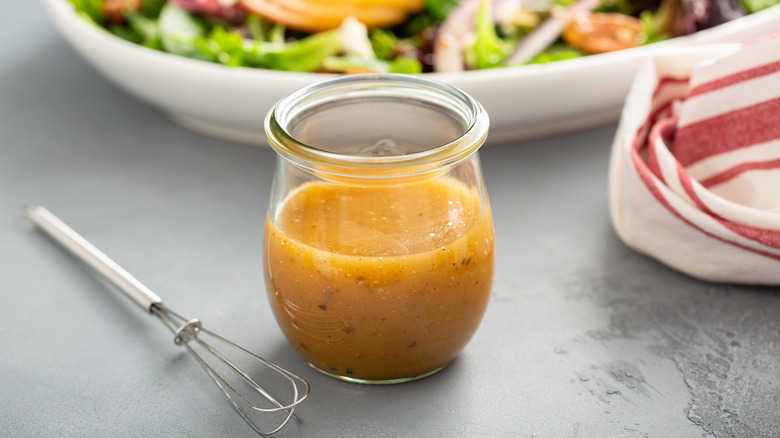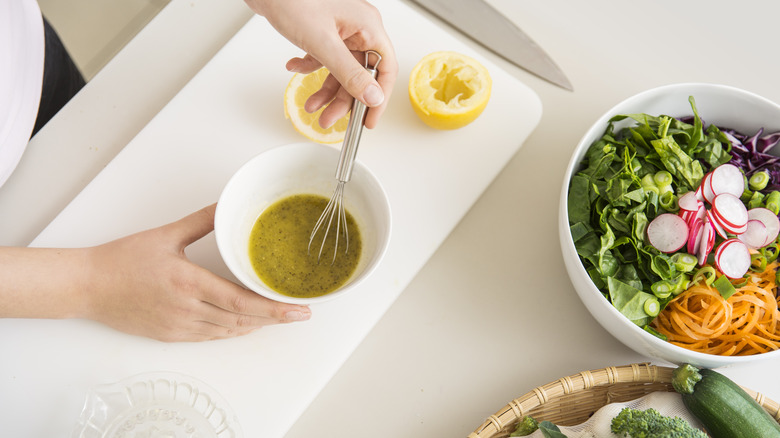Alex Guarnaschelli's Trusted Ratio For Perfect Salad Dressing Every Time
You will not need to spend another second scrolling through blogs or flipping through cookbooks for a salad dressing recipe once you have got chef Alex Guarnaschelli's ratio down. It is easy to remember, relies on pantry staples, and is the perfect foundation for a multitude of flavor combinations. All you need to remember is 3-2-1-1.
Guarnaschelli's recipe combines three parts extra virgin olive oil, two parts red wine vinegar, one part Dijon mustard, and one part water. Using tablespoon measurements will yield about half a cup of vinaigrette, but you can also follow the ratio to scale it up.
To make it, there is no need to dribble in the oil a little bit at a time — this is not a classic homemade aioli recipe. Instead, just whisk everything together in a bowl. You can also put all the ingredients in a resealable bottle or use the mason jar hack — shake well to emulsify. Because this basic dressing includes only ingredients with long shelf lives, you can keep it in the fridge for weeks at a time. However, if you don't have any already on hand, a new batch can really come together in a flash.
Balance is key to a great vinaigrette
Though it may seem a bit counterintuitive to dilute a vinaigrette with water, it is actually super helpful in creating a well-rounded dressing. Adding just a small amount of water, as Alex Guarnaschelli suggests, provides balance — the secret to a great vinaigrette. Olive oil can be peppery and bitter, mustard leans biting and spicy, and vinegar can be harshly acidic. Adding a little bit of water dulls the sharpness of each of those bold components, allowing the flavors of every ingredient to have an equal seat at the table.
The water actually encourages cohesion, and it keeps the texture of the dressing nice and light too. However, if you prefer a thicker sauce, Guarnaschelli does say that you can skip it entirely. A 3-2-1 ratio will still yield a great-tasting result with a perfectly fine consistency.
If you find that the taste is still a bit too biting for your palate, consider adding a little bit of sugar. Even incorporating just a touch mellows out strong flavors without making the vinaigrette taste notably sweet, though you can always add more if you want it to be sweeter. A bit of honey, maple syrup, or agave nectar can go right in. Or, shake everything up in a nearly-empty jam jar to add a fruity touch.
Build off this vinaigrette ratio
Alex Guarnaschelli's ratio does not call for salt and pepper, which is helpful in a foundational recipe. For example, if you are tossing well-seasoned roasted vegetables, you may not need the extra salt since mustard already has some. Those monitoring their sodium intake or with strong sensitivities to salt could also skip it. However, if you are dressing raw veggies or plain cooked grains, some seasoning is definitely in order.
Herbs, spices, and aromatics are also nice additions. Try Italian seasoning and fresh parsley for a pizzeria-style chopped salad, or go for fresh garlic, paprika, and cayenne pepper to play off the flavors of smoky grilled chicken. Feel free to switch the red wine vinegar for whichever other one you prefer such as balsamic, white wine, apple cider, or even citrus juice. Use lime instead, and add in some finely chopped jalapeños and fresh cilantro for a version that is perfect for southwestern salads and burrito bowls.
For meal prepping, you could even batch-make a larger amount for a week's worth of green salads and grain bowls. Then, right before serving, you can doctor up a portion of the dressing with whichever fun additions complement your meal. Guarnaschelli's base dressing is great on a soba noodle salad if you add a hit of soy sauce and crushed peanuts, a peach and mozzarella number with a little fresh basil, or as-is for a simple green salad alongside any of your favorite proteins or pastas.



